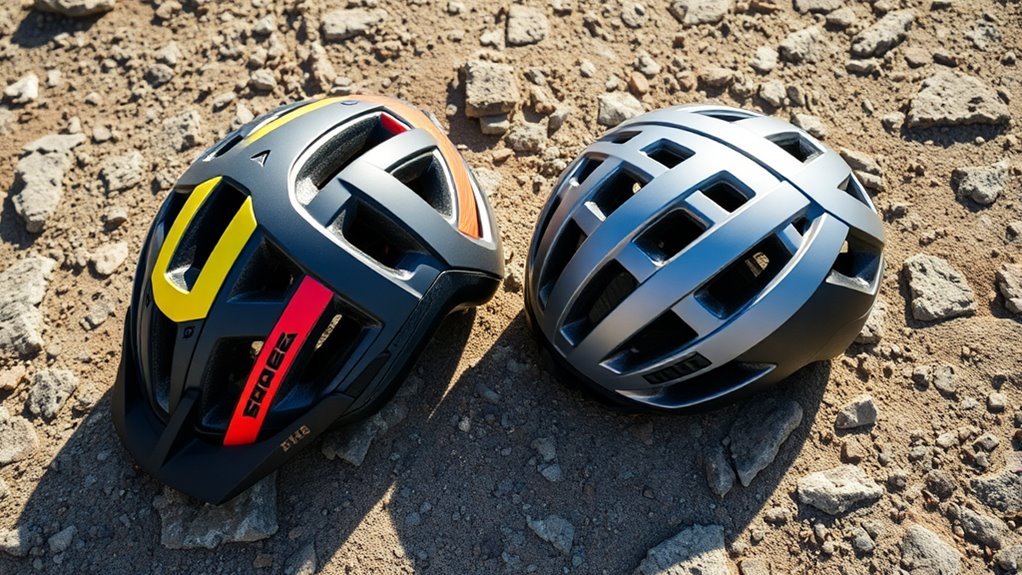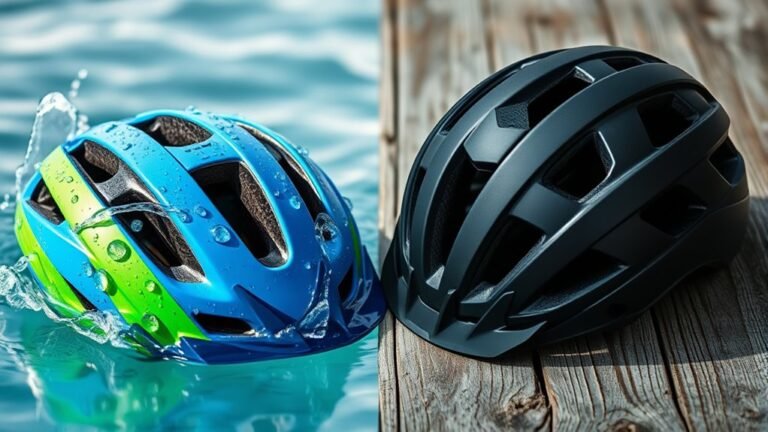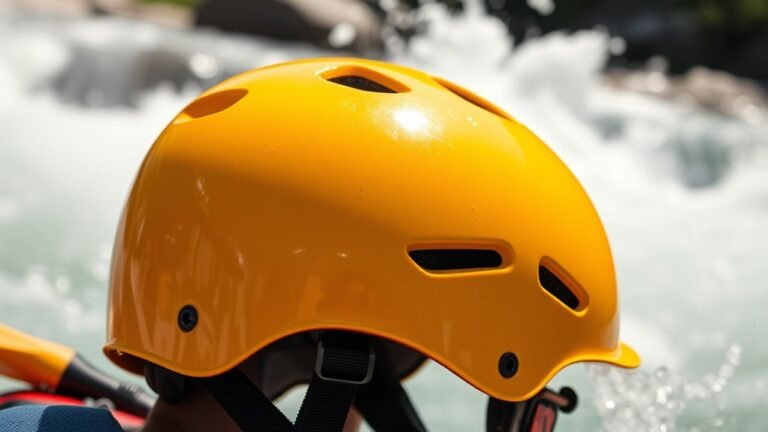Mountain Bike Helmets vs. Road Bike Helmets
When choosing between mountain bike helmets and road bike helmets, consider their distinct purposes. Mountain helmets offer enhanced impact resistance and durability for rugged terrains, while road helmets optimize aerodynamics and lightweight design for speed. Features like ventilation, safety certifications, and comfort levels vary between the two. Ensuring a proper fit is essential for both, as is weighing features against price. Explore further to discover how each helmet can complement your riding style effectively.
Understanding the Purpose of Each Helmet Type
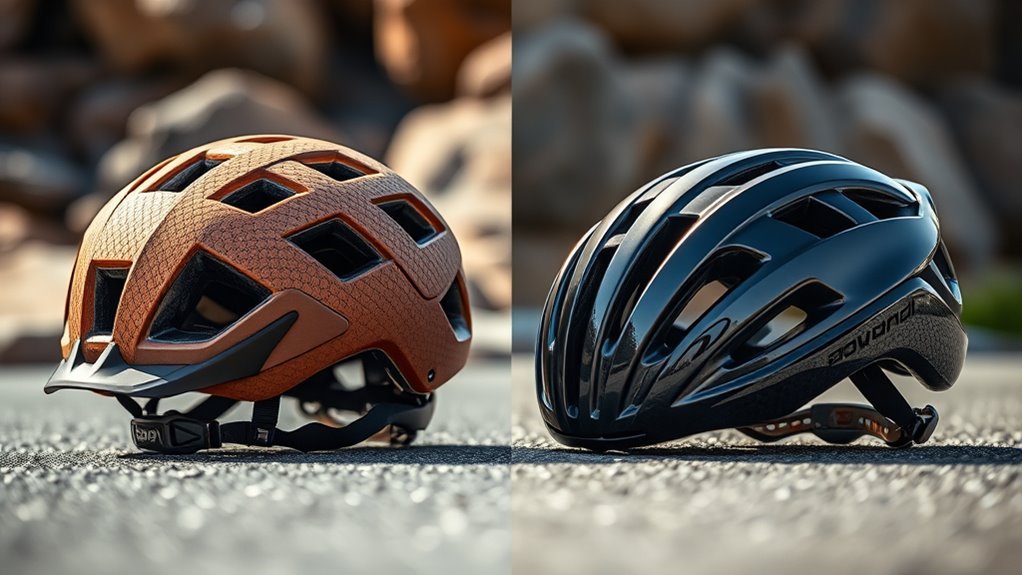
When you consider the differences between mountain bike helmets and road bike helmets, it’s essential to understand their distinct purposes. Mountain bike helmets are designed for rugged terrains, focusing on enhanced impact resistance and durability. They often use robust helmet materials that can withstand falls and debris, safeguarding you during your adventurous rides. In contrast, road bike helmets prioritize aerodynamics and lightweight construction, aiming to reduce drag for speed on smooth surfaces. While they offer adequate impact resistance, their design sacrifices some coverage for venting and weight. Recognizing these differences helps you choose the right helmet that aligns with your riding style and the freedom you seek in your cycling adventures. Ultimately, safety and performance should guide your decision.
Key Features of Mountain Bike Helmets
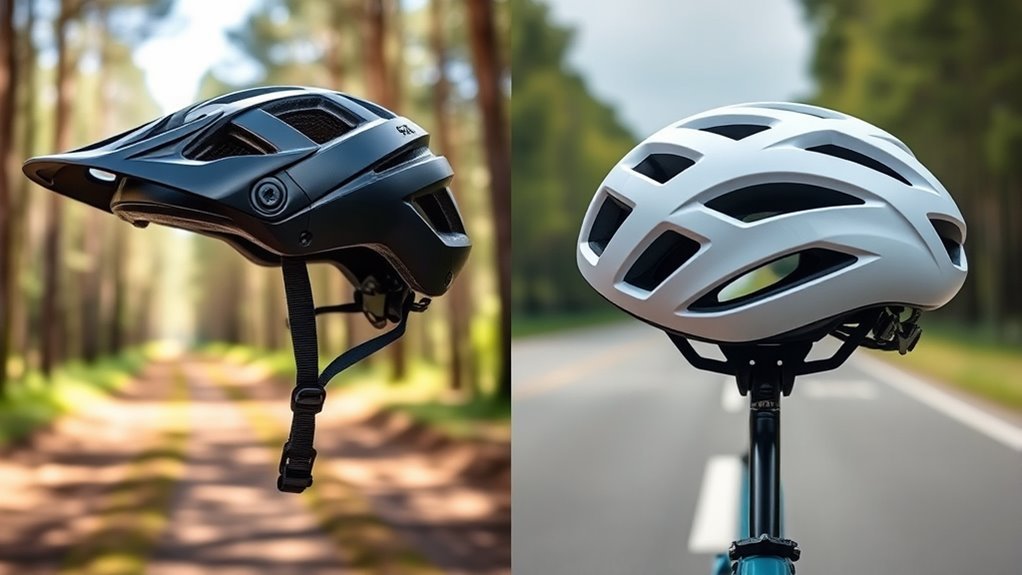
When choosing a mountain bike helmet, you’ll want to focus on key features that enhance your riding experience. Enhanced visor protection helps shield your eyes from debris, while an extended coverage design offers better safety for your head. Additionally, effective ventilation is essential for comfort during intense rides, ensuring you stay cool while traversing rugged trails.
Enhanced Visor Protection
While both mountain bike helmets and road bike helmets offer essential protection, mountain bike helmets typically feature enhanced visor protection tailored to the demands of off-road riding. This visor isn’t just for show; it’s designed for durability, ensuring it can withstand branches, rocks, and other debris that you might encounter on rugged trails. Plus, the visor adjustability allows you to customize its position, optimizing your line of sight and shielding your eyes from sunlight and rain. This flexibility enhances your riding experience, letting you focus on the trail ahead without distractions. Ultimately, investing in a helmet with robust visor features can greatly improve your safety and comfort, giving you the freedom to tackle those challenging terrains with confidence.
Extended Coverage Design
Although road bike helmets focus on aerodynamics, mountain bike helmets prioritize an extended coverage design that enhances safety and protection. This design offers extended coverage benefits, such as increased protection for the back of your head and temples, critical during falls or collisions common in off-road riding. You’ll find that this added security can boost your confidence on technical trails.
However, there are extended coverage drawbacks. The bulkier design can feel heavier and may limit your range of motion compared to road helmets. Additionally, it might not provide the same aerodynamic efficiency, which can affect your speed on flat terrain. Ultimately, weighing these factors will help you choose the best helmet for your riding style and safety needs.
Ventilation for Comfort
Effective ventilation is essential for maintaining comfort during long rides on challenging trails, as it helps regulate temperature and moisture. Mountain bike helmets employ various heat dissipation methods to enhance airflow dynamics, ensuring you stay cool and focused.
- Large vents optimize airflow, allowing for efficient heat escape.
- Internal channels guide air, promoting consistent circulation.
- Moisture-wicking liners absorb sweat, keeping you dry.
- Lightweight materials reduce overall weight, enhancing comfort.
- Adjustable visors help shield from the sun while maintaining airflow.
Key Features of Road Bike Helmets
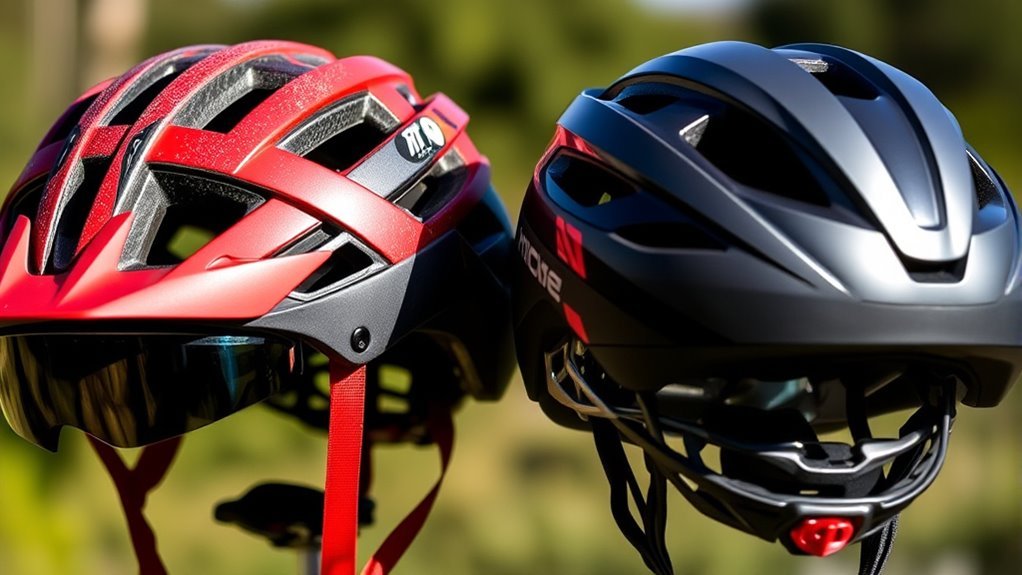
When you’re choosing a road bike helmet, understanding its key features can greatly enhance your riding experience. You’ll want to contemplate the aerodynamic design, as it directly impacts your speed and energy efficiency. Additionally, a well-ventilated helmet is essential for comfort, especially on long rides, while weight plays a significant role in ensuring you don’t feel weighed down.
Aerodynamic Design Importance
As you navigate the world of cycling, understanding the aerodynamic design of road bike helmets becomes crucial for optimizing performance. These helmets offer several aerodynamic benefits that can enhance your ride. Consider the following key features:
- Streamlined Shape: Reduces wind resistance, allowing for smoother rides.
- Minimized Drag: Helps you maintain higher speeds with less effort.
- Lightweight Materials: Guarantees that the helmet doesn’t weigh you down.
- Tailored Fit: Creates a snug fit that reduces airflow turbulence.
- Ventilation Design Optimization: Balances airflow without compromising aerodynamics.
Ventilation System Efficiency
While you may prioritize aerodynamics in a road bike helmet, an efficient ventilation system is equally essential for maintaining comfort during long rides. Effective ventilation technology guarantees that fresh air flows seamlessly through the helmet, enhancing airflow dynamics. This design helps regulate your temperature, preventing overheating as you push your limits on the road. Look for helmets with strategically placed vents and internal channels that promote continuous airflow, diverting heat away from your head. A well-ventilated helmet not only keeps you cool but also helps you stay focused on your ride without the distraction of discomfort. Ultimately, finding the right balance between aerodynamics and ventilation can elevate your cycling experience, allowing you the freedom to explore longer and farther.
Weight and Comfort Factors
Finding a helmet that balances weight and comfort is crucial for any road cyclist looking to maximize performance. A lightweight design can greatly enhance your riding experience, but it shouldn’t compromise comfort. Here are key factors to take into account:
- Weight distribution: A well-balanced helmet reduces neck strain during long rides.
- Comfort padding: Quality padding molds to your head, providing a snug fit without pressure points.
- Chin strap comfort: Verify the strap feels secure yet gentle against your skin.
- Adjustability: Look for easy-to-use sizing systems that allow a personalized fit.
- Moisture-wicking liners: These keep sweat at bay, enhancing comfort during intense rides.
Choosing the right helmet means you can focus on the freedom of the open road, not discomfort.
Safety Standards and Certifications
When choosing between mountain bike helmets and road bike helmets, understanding safety standards and certifications is essential for ensuring your protection on the trails or roads. Both types of helmets undergo rigorous impact testing to determine their ability to absorb shock during crashes. Look for safety certifications like CPSC, ASTM, or Snell, which indicate that the helmet meets specific safety requirements. Mountain bike helmets typically feature enhanced protection around the back and sides, whereas road helmets prioritize ventilation and aerodynamics. It’s vital to select a helmet that aligns with your riding style and safety needs. By prioritizing helmets with verified safety certifications, you can ride confidently, knowing you’re equipped to handle the unexpected while enjoying your freedom on two wheels.
Weight and Design Considerations
As you consider your helmet choices, the weight and design play an essential role in your overall riding experience. A helmet’s weight distribution can greatly affect your comfort and performance, especially on longer rides. You’ll want to find a balance between protection and lightweight materials. Here are key considerations:
- Aerodynamics: A sleeker design minimizes drag.
- Weight: Lighter helmets reduce fatigue during extended rides.
- Fit: Proper design aesthetics guarantee a snug fit for safety.
- Versatility: Consider how the design suits both mountain and road biking.
- Style: A helmet that appeals to your taste encourages consistent use.
Choosing the right helmet involves evaluating these factors to enhance your freedom on the road or trail.
Ventilation and Comfort Levels
While both mountain bike and road bike helmets prioritize safety, their ventilation and comfort levels can vary considerably. Mountain bike helmets often utilize advanced ventilation technology, featuring larger vents to promote airflow during intense climbs and descents. This design helps keep you cool on rugged trails. In contrast, road bike helmets focus on a more aerodynamic shape, often sacrificing some ventilation for speed; however, they still incorporate effective cooling channels. When it comes to comfort materials, mountain bike helmets usually have thicker padding for cushioning on rough terrain, while road helmets emphasize lightweight fabrics that wick moisture. Ultimately, your choice should align with your riding style, ensuring that you enjoy both comfort and performance on your adventures.
Visibility and Accessories
Although both mountain bike and road bike helmets come equipped with features to enhance visibility, their approaches differ greatly. Mountain bike helmets often focus on rugged terrain, while road bike helmets prioritize street safety.
Consider these visibility features and accessory compatibility aspects:
- Bright colors for better visibility in various environments
- Reflective strips to catch the light during low visibility
- Integrated LED lights for increased awareness in the dark
- Visors to shield your eyes from glare while maintaining sight
- Compatibility with glasses or goggles for clear vision
Ultimately, knowing how these elements work can help you choose the right helmet that not only protects but also keeps you visible on your rides, allowing you to enjoy the freedom of cycling safely.
Price Range and Value for Money
When considering a helmet purchase, it’s essential to evaluate the price range and overall value for money, especially since both mountain and road bike helmets can vary markedly in cost. Generally, mountain bike helmets tend to be priced higher due to their additional features, like enhanced protection and ventilation. However, there are budget options available for both types that still provide essential safety without breaking the bank. Conducting a price comparison can help you identify quality helmets within your financial limits. Remember, investing a bit more in a well-constructed helmet often translates to better safety and durability. Ultimately, it’s about finding the right balance between cost and the protection you need for your riding adventures.
Choosing the Right Helmet for Your Riding Style
Finding the right helmet goes beyond just price; it’s about matching the helmet’s features to your specific riding style. Consider the following aspects to guide your choice:
- Helmet fit: Confirm it securely hugs your head without being too tight.
- Ventilation: Look for ample airflow, especially for longer rides.
- Weight: A lighter helmet can enhance comfort on long journeys.
- Visor: A detachable visor can protect against sun and debris, depending on your terrain.
- Safety ratings: Check for certifications that meet or exceed safety standards.
Frequently Asked Questions
Can I Use a Mountain Bike Helmet for Road Biking?
You can use a mountain bike helmet for road biking, but it’s not ideal. Remember, “better safe than sorry.” Mountain biking helmets often prioritize impact protection and ventilation, which can be beneficial, but they might lack aerodynamic features found in road helmets. For helmet safety, confirm it fits well and meets safety standards. While it’s tempting to grab what you have, investing in a dedicated road helmet could enhance your riding experience and safety.
How Often Should I Replace My Bike Helmet?
You should replace your bike helmet every 3 to 5 years, even if it looks fine. Helmets have a limited lifespan due to materials degrading over time, which can affect safety standards. If you’ve been in a crash, it’s vital to replace it immediately, regardless of visible damage. Prioritizing your safety is essential for enjoying your rides, so don’t take chances with an old helmet that might not protect you effectively anymore.
Are There Gender-Specific Bike Helmets Available?
Absolutely, there are gender-specific bike helmets available. Isn’t it fascinating how thoughtful design features can enhance comfort and safety? Women’s fit helmets often come with unique adjustments, providing a snugger fit for different head shapes. These helmets may also incorporate lighter materials and stylish aesthetics, catering to both performance and personal expression. So, when you’re choosing a helmet, consider a women’s fit option that aligns with your riding style and preferences.
What Should I Do if My Helmet Gets Damaged?
If your helmet gets damaged, it’s essential to prioritize helmet safety. Inspect it for cracks or significant dents; if you find any, replace it immediately. Avoid trying to repair it, as that compromises its protective capabilities. Regular helmet maintenance also involves cleaning it gently and storing it away from extreme temperatures. Always remember, your safety depends on your gear, so don’t hesitate to invest in a new helmet when needed.
Do Bike Helmets Come in Different Sizes?
Yes, bike helmets do come in different sizes. But here’s the catch: it’s not just about picking a size off the shelf. You need to get your fit measurement right for maximum safety. Many helmets come with size adjustment features to help you find that perfect snug fit. A helmet that’s too loose or tight can compromise your protection. So, take the time to measure and adjust—your freedom on the road depends on it!
